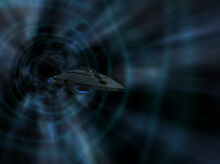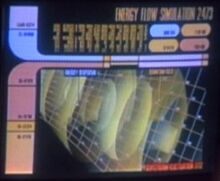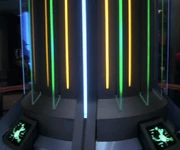
Voyager, utilizing a quantum slipstream drive

A computer simulation of a slipstream
The quantum slipstream drive (also informally called quantum drive or slipstream drive) was an advanced form of interstellar propulsion allowing starships to break through the warp speed barrier. The crew of the USS Voyager acquired the technology in 2374 from Species 116 in the Delta Quadrant. A later test of the drive in 2375 nearly led to the destruction of Voyager, and it was decided to put the use of the device on hold. (VOY episodes: "Hope and Fear", "Timeless")
Generating slipstream corridors requires more processing power than forming warp fields; the computational power required is directly related to the frontal geometry of a vessel and lesser to the ship geometry. Therefore, slipstream propelled ships are generally narrow and compact with aerodynamic lines. However, they are also more energy-efficient than warp drive. (TNG novel: Greater Than the Sum)
History[]

The Dauntless' quantum slipstream drive
The Voyager crew first encountered slipstream technology in 2374, when they discovered the USS Dauntless, a vessel ostensibly sent by Starfleet to transport them back to the Alpha Quadrant. It was subsequently discovered, however, that the vessel was an elaborate ruse by an alien named Arturis, who was seeking revenge on Captain Janeway for what he saw as her complicity in the assimilation of his species by the Borg. Planning to use the Dauntless to transport the Voyager crew back to his Borg-conquered homeworld for assimilation, Arturis settled for Janeway and Seven of Nine when his plot was discovered. Arturis was pursued in the slipstream by Voyager, which had been outfitted with the same technology. Lieutenant Commander Tuvok managed to breach the Dauntless' shields with a photon torpedo, allowing them to rescue Janeway and Seven. Commander Chakotay subsequently ordered their slipstream altered in order to avoid Borg space, leaving Arturis to be assimilated. Voyager remained in the slipstream for an hour before it collapsed, traversing three hundred light years, although their diagnostics concluded that they could not risk using the technology again. (VOY episode: "Hope and Fear")

Voyager's slipstream drive
The next year, the Voyager crew constructed their own quantum slipstream drive using benamite crystals, overcoming some difficulties in their first attempt. Despite promising potential results, Tom Paris discovered a phase variance in the slipstream threshold, threatening to overload the drive's quantum matrix and destroy the ship. Harry Kim realized that the smaller size of a piloted shuttle leading Voyager could allow early phase variance detection of the complex, dynamic slipstream threshold for the larger ship. These advanced data and corrections would help Voyager safely navigate the quantum slipstream.
During the test flight, with Chakotay piloting the Delta Flyer, Kim sent wrong correction values to Voyager, causing the slipstream to unexpectedly collapse ten light years from the Alpha Quadrant. Voyager crashed on an class L planet in the Takara sector, killing all hands – however, ahead of Voyager in the stable Delta Flyer slipstream, Kim and Chakotay survived the disastrous test and returned to Earth, filled with guilt.
Fifteen years later, the pair acquired a stolen Borg temporal transmitter and recovered The Doctor's program from Voyager's debris, and attempted to change history by allowing Voyager to stay in the slipstream. With The Doctor's expertise of Seven of Nine's physiology, Kim and Chakotay used the Borg technology to transmit a time index and new phase corrections back in time to Seven of Nine's interplexing beacon.
The initial corrections did not work – with no chance to correct their mistake, The Doctor convinced Kim to give up on the Alpha Quadrant and at least avert the disaster by transmitting information which would end the flight rather than prolong it. As Seven implemented these new corrections, the slipstream dispersed and returned Voyager safely to normal space – eliminating approximately ten years from their journey to the Alpha Quadrant. (VOY episode: "Timeless")
In 2375, the Think Tank requested quantum slipstream technology as part of the payment for solving the "Hazari paradox." Captain Janeway warned Kurros that they never managed to get the technology to work reliably. Kurros commented that it was still intriguing, "theoretically." (VOY episode: "Think Tank")
In the year 2380, the Vesta-class Federation starship USS Aventine was among the first Starfleet vessels to be fitted with a quantum slipstream drive. (TNG novel: Greater Than the Sum)
By 2381, following the defeat of the Borg, Starfleet began installing quantum slipstream drives on its vessels, but due to the nature of the technology not all ships were compatible with the upgrade. (ST novel: A Singular Destiny)
Later that year, a small contingent of Starfleet vessels, including Voyager, was outfitted with the drives in order to explore the Delta Quadrant in greater detail, and to learn any information available about the Borg. (VOY novel: Full Circle)
Unknown to Starfleet, at the same time, B'Elanna Torres had managed to recreate the technology from memory and outfitted a small vessel with the drive, to evade a fanatical Klingon sect pursuing her daughter. (VOY novel: Full Circle)
Again later that year, starships in Project Full Circle experienced microfractures in their benamite crystals. Voyager's Chief Engineer Nancy Conlon deduced that within three months all the starships in the Delta Quadrant would have to return home if the problem was not solved. (VOY novel: Unworthy)
Security Chief Harry Kim took Nancy Conlon to B'Elanna Torres's personal shuttle, modified with B'Elanna's own version of a quantum slipstream drive and a benamite recrystallization matrix. A conversation between the current and former chief engineers of Voyager resulted in B'Elanna Torres agreeing to adapt her design for use on all of the ships assigned to Project Full Circle. (VOY novel: Unworthy)
In 2382, the Breen accepted a mission on behalf of the Typhon Pact and sent an operative to Utopia Planitia Fleet Yards to capture data pertaining to the quantum slipstream drive. The Breen were soon after contracted to build the first Typhon Pact prototype slipstream vessel. The lead researcher of the project, Thot Keer, intentionally withheld information from the other members relating to the drive's development in order to promote the Breen to a level of Pact authority of equal standing to the Romulans. Shortly before the initial trials, however, the prototype, its designer, and all information relating to the project were destroyed. (ST - Typhon Pact novel: Zero Sum Game)
In 2383, various members of the Pact, led by Sela, attempted to travel to the Gamma Quadrant to obtain Jem'Hadar technology to perfect the drive. They believed that Jem'Hadar ships possessed the right structure to cope with the stresses of slipstream. The attempt resulted in the destruction of Deep Space 9, the bombs were planted to cause a diversion while they used the Bajoran wormhole caused more damage than was intended. (ST - Typhon Pact novel: Plagues of Night)
Further attempts to develop the drive came to an end when the Romulan Praetor officially denounced the Pact's attempt to build a drive, noting that attempts to do so have caused more problems with the Federation than the original existence of the drive, ending their attempts for the time being. (ST - Typhon Pact novel: Raise the Dawn)
It took Starfleet scientists many years to perfect the usage of the slipstream technology, finally making a solid breakthrough in 2384. That year, the USS Intrepid-A was refitted with a quantum slipstream drive and completed a successful test with it. (Star Trek: Intrepid)
By 2384, Starfleet had successfully recreated their own version of the USS Dauntless, captained by Vice Admiral Janeway. (PRO episode: "A Moral Star, Part 2")
- According to Prodigy producer Aaron Waltke, this version of the USS Dauntless was also equipped with a limited form of quantum slipstream, which is why Starfleet repurposed and built a modified recreation of the original design.
In 2385, Federation President Nanietta Bacco offered Odo the use of a Starfleet vessel with quantum slipstream drive to return him home to Dominion space. (DS9 novel: Sacraments of Fire)
By 2409, slipstream drive was standard aboard any vessel that was captained by high-ranking officers in the Federation Starfleet, Klingon Defense Force, and Romulan Republic. These drives could only operate for a short period at a time before shutting down for safety reasons, though in those precious seconds, the starship could cross an entire sector of space. After what was presumably a short period of recharging and re-calibration, they could be activated again for another "sprint".
The Federation Starfleet Odyssey-class, Vesta-class, Hephaestus-class, Phoenix-class, Luna-class, and Chimera-class vessels, Klingon Defense Force Bortas-class and Peghqu'-class vessels, and Romulan Republic Daeinos-class warbirds were equipped with a more advanced version of the same technology, capable of sustaining the slipstream corridor for twice as long, and with a greater degree of maneuverability. Interestingly, a Risian luxury cruiser has been outfitted with a set of special solar sails that allow it to act in the same way as the aforementioned vessels. (STO video game: Star Trek Online)
In 3188, Book implies his ship is capable of slipstream travel, if he had benamite. (DSC episode: "That Hope Is You, Part 1")